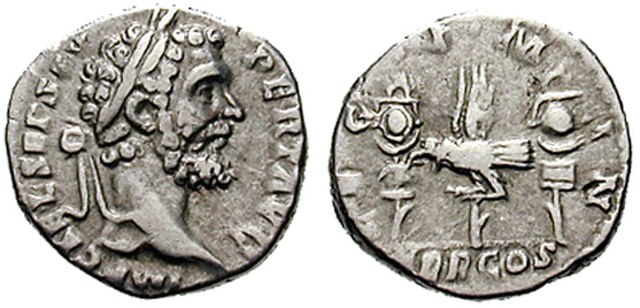Septimus Severus — The African Emperor Coin

Who was Septimius Severus?
Septimius Severus was an important Roman Emperor because he was the first emperor born in Africa. Born in the provincial town of Lepidus (or Lepitus) Magna in what was once Carthaginian territory, Septimius came from a less than fully Roman family. In fact, his father Geta was not born a Roman citizen. Geta descended from from a wealthy and locally powerful Punic family and only became a Roman citizen when Emperor Trajan granted the people of Lepidus Magna citizenship.
What's so Great About Roman Citizenship?

Roman citizenship was a big deal, especially in the early days of Rome. It meant you could vote, run for office, own land, make contracts with other people and access the court of law.
It also meant you had to be treated with a certain amount of respect by the government. You could not be whipped and very rarely were citizens hung on the cross.
Women could be citizens, but female citizenship had far fewer benefits.
Overtime more and more people were granted citizenship by the emperors (mainly because they wanted to tax people!) and so its value and status became less important.
Want learn about slaves getting freedom in Rome? Check out our Liberty Cap Craft.
Septimius rose through the military ranks and his troops declared him emperor after a year of political turmoil throughout the empire. He fought to earn the title and ruled from 193 AD to 211. Famous for his dislike of Christianity, he died in York, England.

Was Septimius Severus Black?
The reality is we may never really know. The color of his skin was not really that important to Romans and so they did not bother to record it.
For the Romans your culture and social graces counted more than skin color. In fact, the Romans looked down on what we would think of as Northern Europeans (today’s Germans and British people) and often enslaved them. The Romans thought those people were unruly, rough, barbarians that needed to be conquered and Romanized (aka civilized).

The missing 3rd Legion Italica Augusta Coin
Septimius Severus owed his power to his military skill and his legions. He issued several coins to celebrate his soldiers. Different legions had different names and many famous legions were given special titles to use due to bravery in battle. He issued one special coin to honor the Legion III Augusta.
The Roman Empire was pretty big and so coins were minted not only in Rome but also throughout the provinces. Often a sample created in Rome was then distributed to other mints.
A mistake happened with the coins for the Legion III Augusta. This legion was stationed in Africa and the coins were minted in Alexandria in Egypt. The Roman sample had the letters “IT” stamped on it. IT stood for Italica, the place were the coin was minted.


When the sample arrived in Alexandria, the minters misunderstood the sample and they minted their coins saying “LEG III IT AVI”, which would read as the 3rd Legion Italica Augusta.
Guess what? There is no 3rd Legion Italica Augusta, so they minted coins for a legion that did not exist!
The problem was quickly later fixed and so very few of the incorrect coins exist today. But it’s still fun story of the missing legion.
Now let’s make our own Severus coin.
Supplies:
- Clay
- Paint (we recommend black and silver, but you really can be creative and use any colors you like!)
- Toothpicks
- Paintbrush



Directions:
- Form your clay into a flat disk
- Look at the coin at the top of our page and copy the picture of Septimius and the eagle on the back as best you can using your toothpick
- Allow the coin to dry
- When the coin is dry, apply a coat of black paint
- Allow the black paint to dry
- Then apply a light coat of silver paint –Don’t add to much you want to see the black paint in the crevices of the coin
- Allow all the paint to dry
